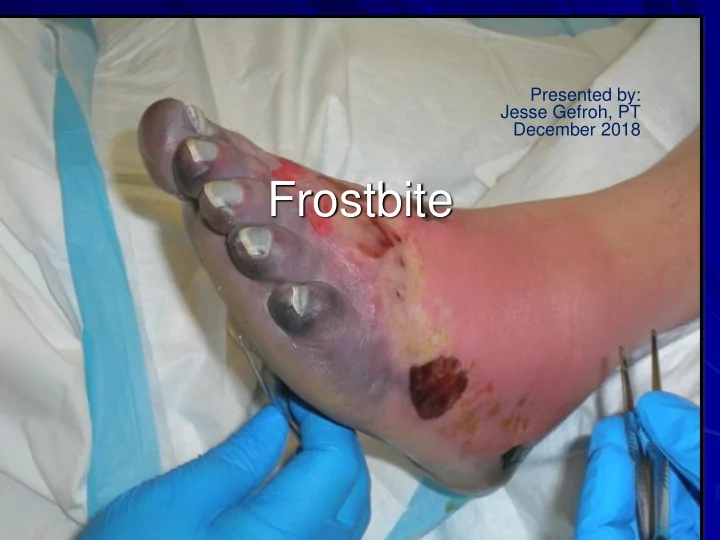

Presented by: Jesse Gefroh, PT December 2018 Frostbite
Objectives Physiology of Frostbite Stages of Care Recommendations for Optimal Healing
Physiology of Thermal Injury Pre-freezing Direct Cell Damage Superficial skin reaches Skin tissue less than 28˚F (- 2˚C) less than 50˚F (10 ˚C) Extracellular ice crystals form “Hunting Reaction” Intracellular dehydration Constriction of ↑ intracellular electrolyte microvasculature System concentrations Increased viscosity of Cellular collapse vascular contents Membrane ruptures Cellular death
Physiology of Thermal Injury cont. Indirect Cell Damage (during re-warming) Microthrombi ↑ blood viscosity Edema formation Progressive Dermal Ischemia Tissue death Nerve and muscle may be affected Note: Edema expected to resolve approximately 72 hours from onset. Gangrenous tissue may be present within 9 days
Prognostic Indicators Favorable Unfavorable Sensation to pin prick Hemorrhagic Bullae Normal skin color Non-blanching cyanosis – “Dipped in grape juice look” Bullae with clear fluid Hard, non-malleable skin Malleable skin
Contributing Factors Alcohol a factor in >60% of all reported cases nationwide YK Delta >90% involve alcohol Equipment Failure Sudden weather changes Inadequate clothing & gear Contributing Medical conditions
Contributing factors cont. Wind chill factor Duration of Exposure Wet Clothing Warm/re-freeze/re-warm cycle Increased damage
Examination & Staging Superficial injury Deep Injury 1 ˚ Insensate central white 3 ˚ Hemorrhagic blisters plaque surrounded by usually followed by ring of hyperemia eschar formation around 2 weeks post injury 2 ˚ Clear/milky within 24 4 ˚ Complete necrosis with hours surrounded with visible tissue loss erythema and edema
Three phases of Treatment 1. Pre-thaw phase — field care 2. Re-warming phase — ED care 3. Post-Thaw phase — IP and OP care
Pre-thaw phase: Field Care Protect, Pad and splint DO NOT RUB Slow re-warming (not supported by literature) Do not attempt to thaw if refreezing is possible
Re-warming phase: ED care Rapid re- warming 98.6˚ – 102.2˚ F Water temperature must remain constant Surgical antimicrobial agent in water bath 30-60 min until thaw complete – Red color, pliable skin Active movement of joint(s) helpful NO MASSAGE/ No PROM See Protocol
Reperfusion Medications Strong recommendation Thrombolytics – tPA (tissue plasminogen activator) Risk of bleeding Use in conjunction with Heparin (usually) Vasodilators – Iloprost (synthetic prostacyclin)
Reperfusion Medications continued: Weak Recommendation Low molecular weight dextran (LMWD) Ibuprofen Topical Aloe Vera
Re-warming Phase Goals Thaw tissue and halt direct cell damage Suppress local & systemic thromboxane production Provide adequate analgesia Prevent infection Maximize tissue retention
Post-thaw Phase: Wound Care To Debride or Not Debride – White or clear blisters = debride (supported by literature) – Hemorrhagic blisters = debated ??? Newer protocols suggest debridement of all blisters
Frostbite Wound Care Goals Promote optimal tissue circulation Control odor Prevent Infection Psychological Support Waiting game for amputation in severe cases – 22-45 days until clear demarcation – ANMC ortho average ~2 months
Standard Frostbite Wound Care Sharp debridement – Frequency Daily if non-viable tissue present and if patient tolerates Whirlpool (2x/day first 72 hours; 1x/day after that) Topicals: Dermaide, Aloe Vera, Bacitrin or Saf-gel * Typical Dressings – Adaptic – Topical – Gauze & gauze rolls Patient Education – NO Nicotine – Protect injured area
Mobility??? Ambulation/Functional mobility – Only if wound is not compromised – Decreased negative effects of immobility – Improved psychological well being * Increased edema, exudate, or pain = no weight bearing
Patient One Injury date: 1/22/17 Surgery: 3/28/17
Jan 27
Feb 3
Feb 15
Feb 21
Patient Two Injury Date: 2/10/17 Surgery: 5/6, 5/8, 5/11, 5/15 Feb 15
Post-debridement Feb 16
Feb 27 March 13
March 23
April 18 R transmetatarsal Amputation L BKA
Patient Three Date of Injury: 11/20 Ortho eval: 1/23/18
November 21
November 27 th Pre and Post Debridement
Dec 4th
Jan 18th
References Wilderness Medical Society Practice Guidelines for the Prevention and Treatment of Frostbite. 1. WILDERNESS & ENVIRONMENTAL MEDICINE, 22, 156 – 166 (2011). Treatment of severe frostbite with Iloprost in Northern Canada. Whitehorse General Hospital. 2. 2016. The evolution of the Helsinki frostbite management protocol.Burns 43 (2017) 1455-1463. 3. Frostbite. Emerg Med Clin N Am 35 (2017) 281-299. 4. Many more available upon request
Appendix 1 YKHC 2017
Appendix 1 Wilderness Medical Society Frostbite Protocol (2011)
Appendix 2 Whitehorse General Hospital Protocol (2016)
Recommend
More recommend